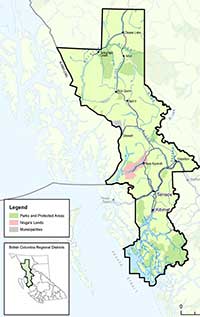Tiny amounts of copper in a river affect a salmon’s sense of smell, making it harder to avoid predators, according to a study at Washington State University.
Jenifer McIntyre says the copper means that a salmon can’t detect another compound that ordinarily alerts them to be still and wary.
The minute amounts of copper can come from mines and even the brake linings of cars.
“A copper-exposed fish is not getting the information it needs to make good decisions,” says McIntyre, a postdoctoral research associate in WSU’s Puyallup Research and Extension Center, whose study built on earlier work that showed that copper can affect a salmon’s sense of smell and thus changing its behavour.
McIntyre put the two together, exposing juvenile coho salmon to varying amounts of copper and placing them in tanks with cutthroat trout, a common predator.
Healthy salmon can smell compounds in the water that are released when another fish is damaged. That substance, called Schreckstoff, German meaning “scary stuff,” alerts fish to nearby predators.
In her experiments, conducted in a four-foot-diameter tank, fish that weren’t exposed to copper would freeze in the presence of Schreckstoff, making it harder for motion-sensitive predators to detect them. On average, half a minute would go by before they were attacked.
But salmon in water with just five parts of copper per billion failed to detect the Schreckstoff and kept swimming. They were attacked in about five seconds.
“It’s very simply and obviously because predators can see them more easily,” says McIntyre. “They’re not in lockdown mode.”
The unwary exposed fish were also more likely to be killed in the attack, being captured 30 percent of the time on the first strike. Unexposed fish managed to escape the first strike nearly nine times out of ten, most likely because they were already wary and poised to take evasive action.
McIntyre also noticed that the behavior of predators was the same whether or not they had been exposed to copper.
Copper finds its way into streams and marine waters from a variety of sources, including motor vehicle brake linings, pesticides, building materials and protective boat coatings. Actual amounts will vary from undetectable in rural or forested areas to elevated in urban areas, especially when runoff from a storm washes roads of accumulated brake dust and other contaminants.
With testimony from McIntyre’s NOAA colleagues and others, the Washington State legislature in 2010 started phasing out copper brake pads and linings over the next 15 to 20 years. According to the state Department of Ecology, brake pads are the source of up to half the copper in the state’s urban waterways.
McIntyre used concentrations of between 5 and 20 parts per billion but has sampled highway runoff with 60 times as much copper. Copper’s effect is mediated by organic matter, which can make the metal unavailable to living things.
“My scenarios are potentially more like a hard-rock copper mining situation than storm water runoff, which typically carries dissolved organic matter along with the copper and other contaminants,” McIntyre says.
A number of large copper mining projects are proposed for the northwest region including, the controversial Taseko’s Prosperity copper mine near Williams Lake which was stopped after the local First Nations and environmental groups opposed the use of one lake for a tailings pond. Taseko is now trying to revive the project. There area also a number of copper mine proposals for the both the northwest BC coast and the Sacred Headwaters region, source of the major salmon rivers, the Skeena, Nass and Stikine. There is also a proposed copper mine Pebble Mine, at Bristol Bay, Alaska, another prime area for sockeye salmon.
Environmental impact of the Canadian copper mine projects are likely to be affected by the provisions of Bill C-38 which speed up environmental assessment and essentially gut habitat protection for fisheries.
Her research, conducted for a University of Washington doctorate with colleagues at UW and the National Oceanic and Atmospheric Administration, appears in the latest issue of the journal Ecological Applications.

